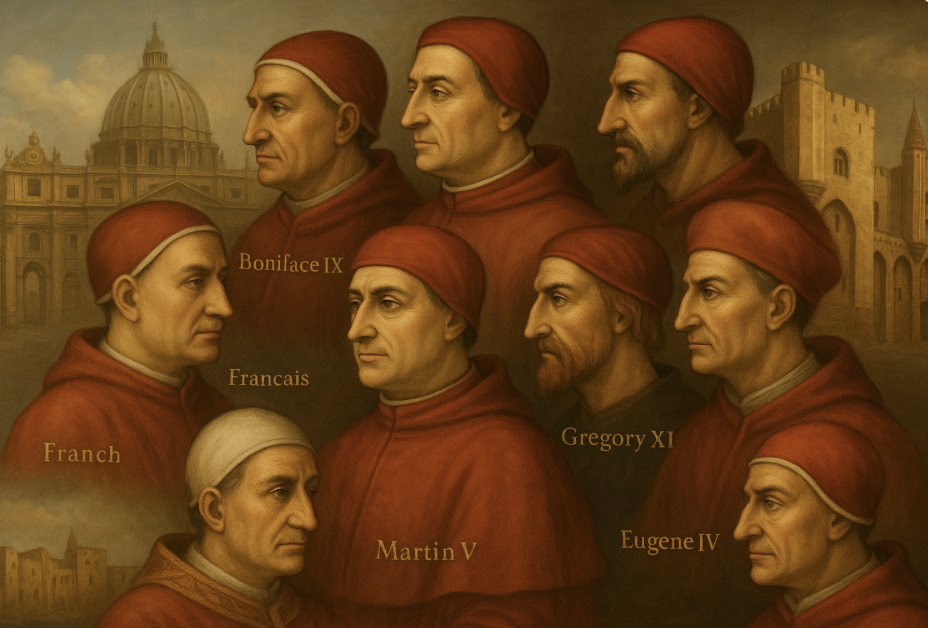

Leonardo Bruni’s career unfolded within a century of intense papal change that shaped the politics, patronage, and civic culture of Italy. The two figures below place Bruni’s life against that institutional background. Figure 1 presents a complete sequence of papal reigns from Urban V to Eugene IV, tagging each pope with their birthplace region, and a pale band marks Bruni’s lifetime. Figure 2 trims the view to only those segments that coincide with Bruni’s years and orders them by overlap, with key milestones and a principal work period annotated. Read together, the graphics clarify not only who ruled in Rome while Bruni wrote, but also how the tempo and geography of papal leadership intersected with his Florentine commitments.
Figure 1. Papal Reigns from Urban V to Eugene IV (1362–1447) with Leonardo Bruni’s Lifetime Highlighted
Each row shows a pope’s reign (neutral bar) with a color-coded region badge beside the name. Bruni’s life (1370–1444) is shaded across the plot.
Figure 1 sets out the succession of papal reigns from Urban V (1362) to Eugene IV (1447). Leonardo Bruni’s lifetime (1370–1444) is shown as a pale vertical band. Each horizontal bar gives a full reign from election to death. The small coloured badge beside each name identifies the pope’s birthplace region: France, Kingdom of Naples, Republic of Venice, or Papal States. The Interregnum appears as its own labeled row.
How to read it.
Time runs left to right in decades. Read across a row to see the length of a reign and where it falls within Bruni’s life. Scan down the badges to observe how the geographical origins of elected popes shift across the period.
What it shows.
Bruni is born at the close of the French, Avignon-era sequence under Urban V and Gregory XI. His formative decades fall within a Neapolitan run under Urban VI, Boniface IX, and Innocent VII, followed by the Venetian Gregory XII. A short interregnum separates that phase from the Roman consolidation under Martin V (Papal States) and the long Venetian pontificate of Eugene IV, which frames Bruni’s mature civic career. The figure places Bruni’s intellectual and public life within the changing political geography of the papacy in late medieval and early Renaissance Italy.
Figure 2. Contemporaneous Papal Reigns During the Life of Leonardo Bruni (1370–1444)
Only overlaps (no extensions), sorted by overlap duration. Bars show years. Bruni milestones and a key work-range are annotated with wrapped, staggered labels.
Figure 2 shows only the parts of papal reigns that coincide with Leonardo Bruni’s life (1370–1444), ordered by the length of the overlap. Each horizontal bar represents the contemporaneous segment of a pontificate; the number at the bar’s right gives the duration in years. The thin dashed lines mark Bruni’s birth and death. A pale vertical band indicates his principal working years (c. 1416–1442). Milestones appear above the axis: Laudatio Florentinae urbis (1403), Chancellor of Florence (1427), and the Council of Florence (1439).
How to read it.
Scan top to bottom to see which popes were Bruni’s most sustained contemporaries, then read left to right to place those overlaps against his milestones.
What it shows.
Bruni’s early formation falls under the tail end of the Avignon papacy (Gregory XI, 7.2 years) and, more substantially, under Urban VI (11.5 years). His mature civic and literary career aligns with long overlaps under Martin V (13.3 years) and Eugene IV (13.0 years), with a brief interregnum (2.4 years) between Gregory XII and Martin V. The figure highlights that Bruni’s major works and offices coincide with the papacy’s consolidation in Rome after the Schism, a political settlement that frames the world his history seeks to explain.
Conclusion
Bruni’s early decades coincide with the end of the French Avignon pattern, followed by a Neapolitan run; his mature work aligns with the Roman consolidation under Martin V and the long Venetian pontificate of Eugene IV. The longest overlaps occur precisely during the years when Bruni held office and produced major texts, a reminder that humanist scholarship and papal politics were closely intertwined. The birthplace badges highlight a shift in papal origins that mirrors wider regional dynamics in late medieval Italy. These are simple timelines, yet they offer a compact frame for reading Bruni’s works in context and for asking further questions about patronage, diplomacy, and the circulation of texts across papal and communal institutions.

